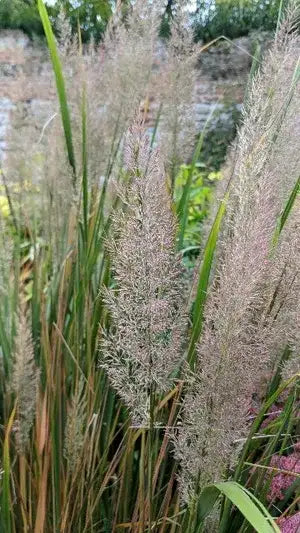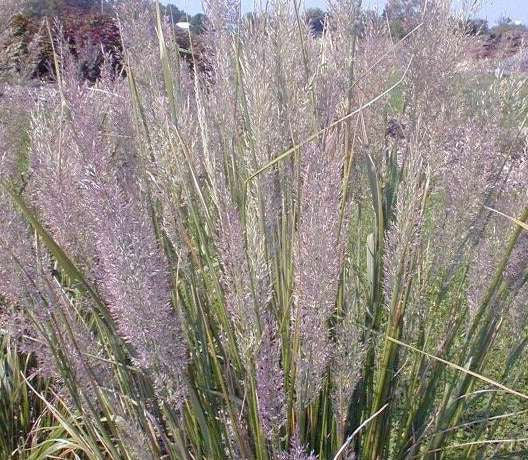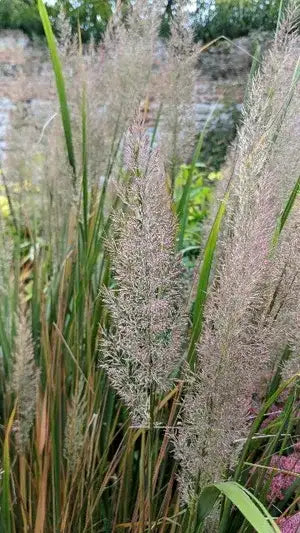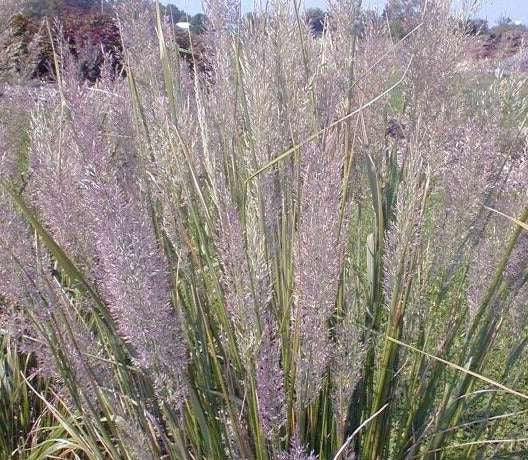Calamagrostis brachytricha
Calamagrostis brachytricha
Korean Feather Grass
Couldn't load pickup availability
Calamagrostis brachytricha 'Korean Feather Grass' - Organic Hardy Perennial Grass
A stunning ornamental grass that brings architectural elegance and soft movement to the garden. This clump-forming perennial produces spectacular feathery plumes that emerge pink-tinged in late summer, maturing to silvery-grey with cream tones through autumn and winter. One of the few ornamental grasses that performs beautifully in partial shade, making it incredibly versatile for different garden situations.
Plant Features Forms an elegant fountain of bright green, arching foliage reaching 60-90cm tall and wide. The dramatic flower plumes rise majestically above the leaves to 120cm, creating striking vertical interest. Unlike many ornamental grasses, this warm-season beauty blooms later in summer and maintains its structure well into winter. The overall habit is neat and architectural with graceful movement in the slightest breeze.
Flowers Spectacular feathery bottlebrush plumes emerge purplish-red with pink tints in late summer, aging gracefully to silvery-grey and cream tones. The fluffy, delicate texture creates wonderful contrast against the linear foliage. Plumes hold their beauty through autumn and winter, providing four-season interest. Perfect for cutting and dried flower arrangements.
Growing Requirements Thrives in full sun to partial shade - one of the few ornamental grasses that blooms well in light shade. Prefers consistently moist, well-draining soil but adapts to various conditions including heavy clay. More drought tolerant once established than many grasses. Appreciates some afternoon shade in very hot climates.
Plant Partnerships Works particularly well with:
- Asters - complementary autumn flowering
- Sedum 'Autumn Joy' - similar timing and texture contrast
- Japanese Anemone - woodland garden companions
- Heuchera - contrasting foliage at base
- Late-flowering perennials - extends seasonal interest
Excellent for:
- Mixed borders
- Specimen planting
- Mass plantings for dramatic effect
- Woodland gardens
- Stream or pond margins
- Contemporary landscape design
- Winter interest gardens
Wildlife Value Seeds provide valuable food for birds throughout winter. The dense clumps offer shelter for beneficial insects and small wildlife. Relatively pest and deer resistant. The late-season flowers provide nectar when many other plants are finishing.
Gardening Tips
- Plant in spring or autumn
- Space plants 60-90cm apart
- Water well during establishment, then drought tolerant
- Work compost into soil at planting
- Cut back to ground level in late winter before new growth
- Divide clumps every 4-5 years if desired
- Plumes excellent for cutting and drying
- Self-seeds gently in favorable conditions
This exceptional grass brings year-round structure and movement to borders while requiring minimal maintenance. The late-summer flowering extends the garden's seasonal interest, and the winter plumes provide architectural beauty when most plants have died back.
Selected for its reliability, shade tolerance, and spectacular plumes. Perfect for gardeners wanting low-maintenance plants that deliver maximum impact while supporting wildlife through the colder months.
Plant care guide
Plant care guide
How do you plant ornamental grasses?
Dig a hole slightly larger than the rootball size, but no deeper. Most grasses like to stay on the drier side (check plant details), so if your soil is a bit heavier than ideal make the hole slightly shallower than the root ball so the surface of the rootball sits proud of the ground and ad organic matter around the circumference in a berm to sop water pooling
Water the hole and if the plant rootball doesn't seem moist pre-soak the hessian contained rootball until it is saturated (no more bubbles rise to the surface).
There is normally no need to add compost to the hole if you have an established garden with healthy plants already growing. If you have a newbuild property or poor growth to existing plans chances are that your whole fowerbed needs improving with organic matter. If you have heavy soil grasses some may struggle so consider topdressing plenty of organic matter over a few years before choosing grasses.
Place the rootball in the hole. You can remove the hessian sacking it came in, or just remove the staple/twine and open the top once it's in the ground so the plant is free. The roots will easily grow through and the hessian will decompose. Back fill the surrounding area with the dug soil. Do not firm the soil down hard! Roots need air and water and hard compacted soil prevents them from getting both.
Once planted water the plant in well and then water again whenever the soil starts to dry out under the surface for the first year. Be careful not to overwater.
Mulching with something like woodchips around the plant after watering will help the soil to retain the moisture in hot weather. Perennial's Grasses ofen have deciduous foliage that will die off in the winter - this can be left up as looks attractive and also provides a habitat for overwintering insects.
When to plant ornamental grasses in the UK?
Perennial plants can be planted out in the garden or in pots from spring, through the summer, to the autumn. During dry weather and especially during the summer much closer attention needs to be given to watering in the first year.
If planting in hot weather, cut the foliage and flowers back. Your new plant will not be taking up much water until established so may struggle if the leaves lose more water than the roots can absorb. For the strongest result do not allow to flower or at least to set seed in the first year.
Where to plant ornamental grass?
Check the plant info at the bottom of the page for the best place to position your new plant. If it prefers sun and you plant it in a north facing flowerbed next to a wall don't expect it to thrive or flower.
Pay attention to the soil. If it is heavy clay, incorporate organic matter such as compost to the soil before planting your grass, preferably to the whole flowerbed. This will improve the soil by buffering it's water and nutrient holding ability. It is preferable to not just plonk compost in the bottom of the hole as it will not improve the overall condition of the soil surrounding your new plant. Do not add a layer of gravel or grit to the bottom of the hole as this will merely cause the perched water table to be higher. It will not improve drainage.
How do you care for perennial grasses?
Cut back untidy foliage in the spring (you can leave the clippings on the flower bed to allow the nutrients to recycle into the soil). Divide every 3 to 5 years as the centre dies out and replant your extra plants! Perennial grasses come back every year. Some are longer living than others.
Should ornamental grasses be fertilised?
The vast majority of garden soils contain plenty of nutrients, but if your garden is in a newly built development there is a good chance a thin layer of topsoil has been added on top of infertile subsoil. if that is the case, compost, soil improver or well rotted manure can be spread on the flower bed and dug in, or alternatively for those short of time or energy, organic fertiliser such as our own special organic mix of bone meal, hoof and horn and vinaase that is an organic, sustainable alternative to the John Innes formula, can be sprinkled around the plant with some compost added to the planting hole.
Delivery £5 flat rate or FREE over £50 spend.
Delivery £5 flat rate or FREE over £50 spend.
I charge a flat rate of £5 for postage and packaging to all of Britain, including the Highlands and the Isle of Man, with free delivery for orders over £50. We are unable to send plants to Northern Ireland.
I use Royal Mail for our deliveries as they have the lowest carbon footprint per parcel delivered in the UK and actually tend to look after parcels rather than just chucking them over the nearest fence! This ensures that your plants will have the best care possible.
Please have a Safe Place set up if possible so your plants are not returned to the sorting office if no one is home to accept the delivery.
I try to dispatch plants twice a week and you will receive updates by text or email. In cases of extreme weather or if Royal Mail has a hiccup the delivery may be delayed but we'll keep you in the loop.
I'm unable to deliver to the Channel Islands or Northern Ireland.
The LAWNMOWER Guarantee
The LAWNMOWER Guarantee
Healthy plants & happy customers
Your plant will only be dispatched if I'm happy it is healthy. The nature of growing the plants in large troughs means that the root system will be trimmed before they are balled in hessian, and therefore, depending on the time of year, the top growth may also be trimmed to make sure the roots are able to supply the water and nutrients your new plant requires.
Pruning encourages new growth and this applies to roots as well so a pruned plant actually results in a stronger plant.
The LAWNMOWER guarantee.
If you're not happy with your plants for any reason, even if you've run them over with your lawnmower, just pop them in a box (the plants, not the mower!) and post them back to us within 1 year for a replacement or refund.
This does not affect your statutory rights.
For full details check out the Refunds and Returns Policy.
Sustainability
Sustainability
Eco-friendly business
Fed up with plants grown in plastic pots which are doused in herbicides and sprayed with synthetic chemicals by big nurseries who merrily burn through finite resources, fly plants in from abroad on jet planes, irresponsibly use peat and coir, kill any insect nearby with non-selective pesticides and generally only think of the bottom line?
So are we!
How we grow plants sustainably
Our plants are started in coldframes or inside our house, grown-on woodfibre pots or in reclaimed wooden troughs which are then carefully harvested and balled and burlapped (hessian wrap securing the rootball), before packing plastic free in a eco cardboard box from a certified B-corp carbon neutral supplier. Some plants are grown in 8cm woodfibre pots.
Sustainable and organic compost & fertiliser
Our Soil Association certified organic compost is bought in bulk without plastic bags from Dalefoot Compost, and consists of sheep wool, bracken and comfrey. This naturally feeds the plants for 12 months. If supplemental feeding is required we only use our own special blend of organic fertilisers (bone meal, hoof & horn and vinaase) which have been processed with solar energy.
Carbon Neutral business
The small amount of electricity we use is from renewable sources and we irrigate our plants with stored water we have harvested. Plus, we are using our house and land for more than one purpose, preventing further land use and utilising the sunk carbon cost of the building rather than creating more.
We have partnered with Carbon Neutral Britain to offset our emissions, and recognise that we are not in control of all parts of the supply chain so have fully offset scopes 1, 2 and 3 to take that in to account - so that's all emissions connected to our business, from the farts coming out of the back of the sheep, to the carbon dioxide from the delivery van outside your door.
We don't just offset and carry on, ALL the decisions we make work to reduce emissions - for instance we use Royal Mail to post our plants as they have by far the lowest carbon footprint per parcel delivered in the UK.
Calamagrostis brachytricha
View full details



